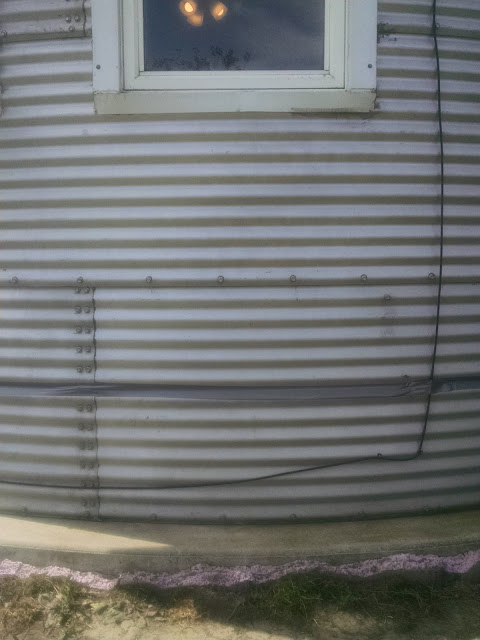Last September I blogged about the condensation problem we had on the floor inside the grain bin house and our plans to fix it , but first let me backtrack a bit.
Originally, when we built our "Looney Bin" (summer of 2015) we had poured the foundation of the bin and then placed pink solid foam boards between the foundation and the earth bermed up next to it. In the picture below the pink foam board had been picked at by our chickens but what you cannot see in the additional 2 feet of foam UNDER the ground.
We had never built or insulated a grain bin home before and neither had the man who did the foundation for us, so it was a collaborative effort between us. We hoped that by placing the foam board between the concrete foundation and the soil, it would help keep the concrete floor warm in our new abode.
The floor did stay warm, mostly because of the pipe within the floor where the hot gases from the rocket mass stove travel until they go out our chimney, but the portion of our concrete floor nearest the circular wall, stayed cool. Condensation built up on our inside floor about 6 to 12 inches away from the inside wall. We also had a little mold growing in that area.
In the winter of 2017 we bought a dehumidifier which helped some but did not completely eliminate the problem.
Thus, in the Fall of 2017 Keith called the company that did our interior wall insulation and asked their opinion on the floor condensation. They suggested a layer of spray on foam applied to the outside of the grain bin itself. It looked like this:
Over the last eight months the lovely mint green color of the spray on foam changed to a not so lovely Harvest Gold of the seventies.
I think Carol Brady would approve.
But, it accomplished it's goal of eliminating the condensation buildup on the inside floor. This past winter we had no moisture or mold on our concrete floor. Happy days! It also stayed intact through rain, ice and snow storms which our insulation guy said it would.
Our next task is to build seating to cover the insulation around the diameter of the entire looney Bin.The seat sides will be made with additional grain bin steal we had purchased from our builder last fall, and will have a wooden top. Which of course must be cut to fit the curved sides of the bench. We might even attach some hinges to some areas in order to store items within the bench such as garden tools, laundry baskets, flower pots, blankets for outdoor seating...once again, the possibilities are endless.























